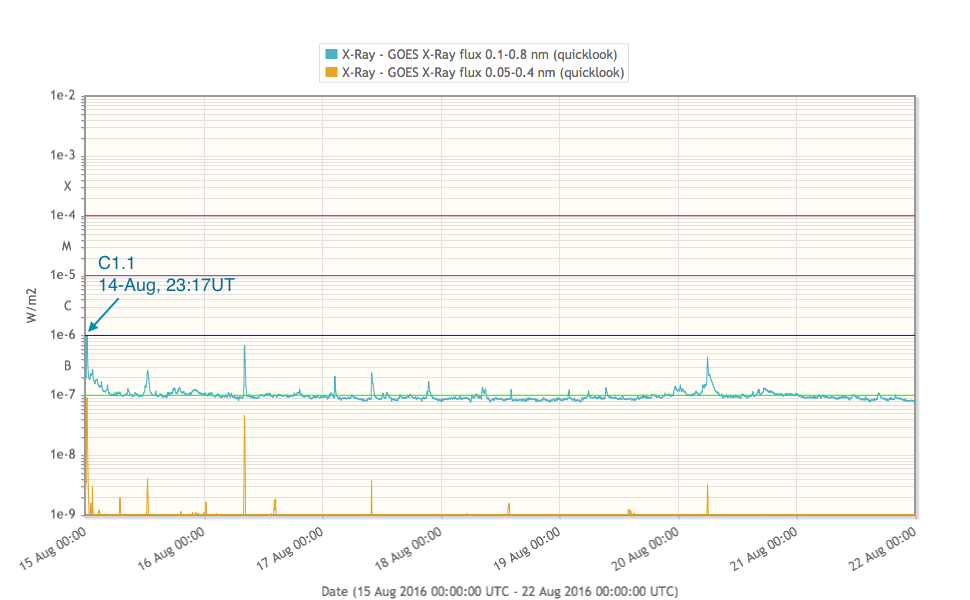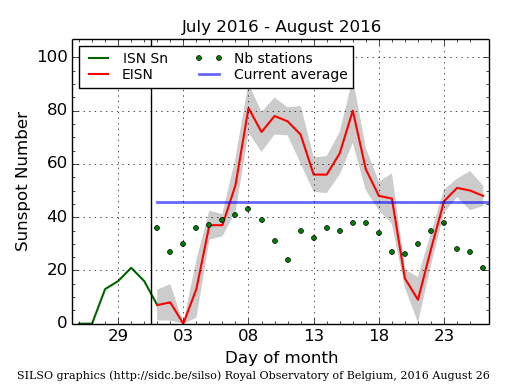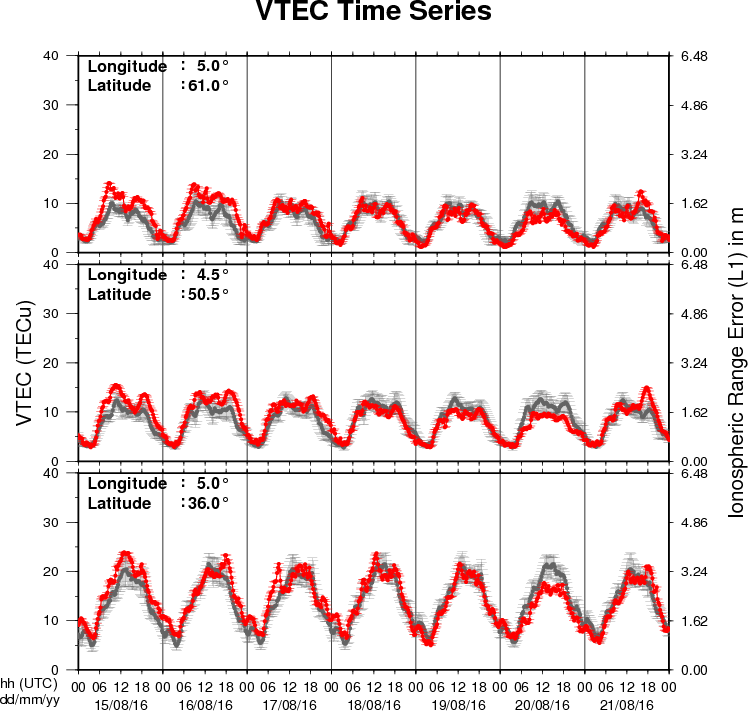- Table of Content
- 1.PROBA2 Observa...
- 2.Review of sola...
- 3.The Internatio...
- 4.Review of geom...
- 5.Geomagnetic Ob...
- 6.Review of iono...
- 7.Future Events
2. Review of solar activity
3. The International Sunspot Number
4. Review of geomagnetic activity
5. Geomagnetic Observations at Dourbes (15 Aug 2016 - 21 Aug 2016)
6. Review of ionospheric activity (15 Aug 2016 - 21 Aug 2016)
7. Future Events
PROBA2 Observations (15 Aug 2016 - 21 Aug 2016)
Solar Activity
Solar flare activity fluctuated between very low and low during the week.
In order to view the activity of this week in more detail, we suggest to go to the following website from which all the daily (normal and difference) movies can be accessed: http://proba2.oma.be/ssa
This page also lists the recorded flaring events.
A weekly overview movie can be found here (SWAP week 334).
http://proba2.oma.be/swap/data/mpg/movies/weekly_movies/weekly_movie_2016_08_15.mp4
Details about some of this week’s events, can be found further below.
If any of the linked movies are unavailable they can be found in the P2SC movie repository here
http://proba2.oma.be/swap/data/mpg/movies/
Monday Aug 15

An eruption was observed by SWAP on the north east limb of the Sun on 2016Aug15 at 17:00
UT
Find a movie of the event here (SWAP movie)
http://proba2.oma.be/swap/data/mpg/movies/20160815_swap_movie.mp4
Review of solar activity
Solar activity was very low. Only background B-class flares were observed. (Two C1.1 flares were however observed from active region NOAA AR 2578 peaked at 19:36 UT and 23:17 on 14-Aug-2016).

Four active regions were observed on the visible side of the solar disc. Their photospheric magnetic field configuration was simple (alpha and beta configuration). By the end of the week, only NOAA AR 2578 with a alpha magnetic configuration remained on the solar disc.

A low latitude coronal hole in the southern hemisphere with negative polarity was present. No Earth-directed CMEs were observed. Solar proton flux intensity remained at the background levels.
The International Sunspot Number

The daily Estimated International Sunspot Number (EISN, red curve with shaded error) derived by a simplified method from real-time data from the worldwide SILSO network. It extends the official Sunspot Number from the full processing of the preceding month (green line). The plot shows the last 30 days (about one solar rotation). The horizontal blue line shows the current monthly average, while the green dots give the number of stations included in the calculation of the EISN for each day.
Review of geomagnetic activity
The variations of the solar wind parameters were weak. Solar wind speed remained below 400 km/s during most of the time (except midnight on 21-Aug-2016, when the speed increased till about 450 km/s. The magnitude of the Interplanetary Magnetic Field (Bt) were below 8 nT most of the time (again except midnight on 21-Aug-2016) while Bz component were fluctuating between about +-6 nT.

The geomagnetic conditions have been quiet (K Dourbes between 1 and 3; NOAA Kp between 1 and 3). No geomagnetic storms were observed. Only once Kp index elevated till Kp=4 on 21-Aug-2016.
The fast wind catching up the slow wind, sparked aurora in the early night of August 24: check http://www.stce.be/node/315
Review of ionospheric activity (15 Aug 2016 - 21 Aug 2016)

The figure shows the time evolution of the Vertical Total Electron Content (VTEC) (in red) during the last week at three locations:
a) in the northern part of Europe(N61°, 5°E)
b) above Brussels(N50.5°, 4.5°E)
c) in the southern part of Europe(N36°, 5°E)
This figure also shows (in grey) the normal ionospheric behaviour expected based on the median VTEC from the 15 previous days.
The VTEC is expressed in TECu (with TECu=10^16 electrons per square meter) and is directly related to the signal propagation delay due to the ionosphere (in figure: delay on GPS L1 frequency).
The Sun's radiation ionizes the Earth's upper atmosphere, the ionosphere, located from about 60km to 1000km above the Earth's surface.The ionization process in the ionosphere produces ions and free electrons. These electrons perturb the propagation of the GNSS (Global Navigation Satellite System) signals by inducing a so-called ionospheric delay.
See http://stce.be/newsletter/GNSS_final.pdf for some more explanations ; for detailed information, see http://gnss.be/ionosphere_tutorial.php
Future Events
For more details, see http://www.spaceweather.eu/en/event/future
Horizon 2020 Space Work Programme 2018-2020 Stakeholder Consultation Workshop, in Brussels, Belgium
Start : 2016-09-26 - End : 2016-09-28
In the context of preparing the Horizon 2020 Space work
programme 2018-2020, the European Commission organises a dedicated
stakeholder consultation workshop. The main objective of this event
is to further involve all relevant European stakeholders in the
definition of the next Horizon 2020 Space work programme,
highlighting the main priorities and trends.
The participation to the workshop is free and open to all
relevant stakeholders, limited only by the capacity of the
conference rooms. Delegations, European associations and other
stakeholder groups are encouraged to forward this invitation to
their respective constituents and members.
Website:
https://h2020-space-wp-2018-20.teamwork.fr/en/programme
4th Asia Oceania Space Weather Alliance (AOSWA) Workshop, in Jeju, Republic of Korea
Start : 2016-10-24 - End : 2016-10-27
Website:
http://aoswa4.spaceweather.org/index.php
Global Modelling of the Space Weather Chain in Helsinki, Finland
Start : 2016-10-24 - End : 2016-10-28
This event brings together solar, heliospheric, magnetospheric,
and ionospheric communities to discuss the current state and future
challenges in global modelling of the entire space weather chain.
Major developments in forecasting space weather, and understanding
the effects of solar eruptions requires increased communication and
collaboration of these often rather distinct communities. We
welcome submissions from these modelling communities and also
synergetic studies utilising both observations and numerical
models.
Website:
https://pnst.ias.u-psud.fr/sites/pnst/files/global_modelling_space_weather_oct2016.pdf
European Space Weather Week in Ostend, Belgium
Start : 2016-11-14 - End : 2016-11-18
The ESWW is the main annual event in the European Space Weather
calendar. It is the European forum for Space Weather as proven by
the high attendance to the past editions. The agenda will be
composed of plenary/parallel sessions, working meetings and
dedicated events for service end-users. The ESWW will again adopt
the central aim of bringing together the diverse groups in Europe
working on different aspects of Space Weather.
Website:
http://www.stce.be/esww13/
4th SOLARNET Meeting: The Physics of the Sun from the Interior to the Outer Atmosphere, in Lanzarote (Spain)
Start : 2017-01-16 - End : 2017-01-20
The IV SOLARNET MEETING 'The physics of the Sun from the
interior to the outer atmosphere' will take place in Lanzarote
(Spain) from 16th to 20th of January 2017, organized by the
Instituto de AstrofÃsica de Canarias (IAC).
SOLARNET (High-resolution Solar Physics Network) is an EU-FP7
project coordinated by IAC with the aim of bringing together and
integrating the major European research infrastructures in the
field of high-resolution solar physics. SOLARNET involves all
pertinent European research institutions, infrastructures, and data
repositories. Networking activities, access to first-class
infrastructures and joint research and development activities are
being covered under SOLARNET to improve, in quantity and quality,
the service provided by this European community.
The purpose of this conference is to provide a coherent picture
of the Sun as a single physical system playing all the underlying
physical processes measured and observed in the solar atmosphere to
date.
Website:
http://www.iac.es/congreso/solarnet-4meeting/
Solar Orbiter Workshop 7: Exploring the solar environs in Granada, Spain
Start : 2017-04-03 - End : 2017-04-06
This event will be hosted by the Instituto de Astrofisica de
Andalucia - CSIC. Please mind that on April 7th the 20th SWT
meeting will take place at the same venue.
Website: Unkown
